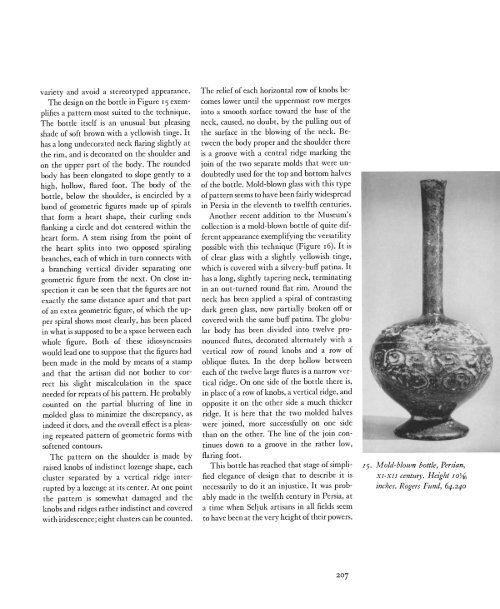Islamic Art: The Metropolitan Museum of Art Bulletin, v. 23, no. 6 ...
Islamic Art: The Metropolitan Museum of Art Bulletin, v. 23, no. 6 ...
Islamic Art: The Metropolitan Museum of Art Bulletin, v. 23, no. 6 ...
You also want an ePaper? Increase the reach of your titles
YUMPU automatically turns print PDFs into web optimized ePapers that Google loves.
variety and avoid a stereotyped appearance.<br />
<strong>The</strong> design on the bottle in Figure 15 exem-<br />
plifies a pattern most suited to the technique.<br />
<strong>The</strong> bottle itself is an unusual but pleasing<br />
shade <strong>of</strong> s<strong>of</strong>t brown with a yellowish tinge. It<br />
has a long undecorated neck flaring slightly at<br />
the rim, and is decorated on the shoulder and<br />
on the upper part <strong>of</strong> the body. <strong>The</strong> rounded<br />
body has been elongated to slope gently to a<br />
high, hollow, flared foot. <strong>The</strong> body <strong>of</strong> the<br />
bottle, below the shoulder, is encircled by a<br />
band <strong>of</strong> geometric figures made up <strong>of</strong> spirals<br />
that form a heart shape, their curling ends<br />
flanking a circle and dot centered within the<br />
heart form. A stem rising from the point <strong>of</strong><br />
the heart splits into two opposed spiraling<br />
branches, each <strong>of</strong> which in turn connects with<br />
a branching vertical divider separating one<br />
geometric figure from the next. On close inspection<br />
it can be seen that the figures are <strong>no</strong>t<br />
exactly the same distance apart and that part<br />
<strong>of</strong> an extra geometric figure, <strong>of</strong> which the upper<br />
spiral shows most clearly, has been placed<br />
in what is supposed to be a space between each<br />
whole figure. Both <strong>of</strong> these idiosyncrasies<br />
would lead one to suppose that the figures had<br />
been made in the mold by means <strong>of</strong> a stamp<br />
and that the artisan did <strong>no</strong>t bother to correct<br />
his slight miscalculation in the space<br />
needed for repeats <strong>of</strong> his pattern. He probably<br />
counted on the partial blurring <strong>of</strong> line in<br />
molded glass to minimize the discrepancy, as<br />
indeed it does, and the overall effect is a pleasforms<br />
with<br />
ing repeated pattern <strong>of</strong> geometric<br />
s<strong>of</strong>tened contours.<br />
<strong>The</strong> pattern on the shoulder is made by<br />
raised k<strong>no</strong>bs <strong>of</strong> indistinct lozenge shape, each<br />
cluster separated by a vertical ridge inter-<br />
<strong>The</strong><br />
rupted by a lozenge at its center. At one point<br />
the pattern is somewhat damaged and the<br />
k<strong>no</strong>bs and ridges rather indistinct and covered<br />
with iridescence; eight clusters can be counted.<br />
relief <strong>of</strong> each horizontal row <strong>of</strong> k<strong>no</strong>bs becomes<br />
lower until the uppermost row merges<br />
into a smooth surface toward the base <strong>of</strong> the<br />
neck, caused, <strong>no</strong> doubt, by the pulling out <strong>of</strong><br />
the surface in the blowing <strong>of</strong> the neck. Between<br />
the body proper and the shoulder there<br />
is a groove with a central ridge marking the<br />
join <strong>of</strong> the two separate molds that were undoubtedly<br />
used for the top and bottom halves<br />
<strong>of</strong> the bottle. Mold-blown glass with this type<br />
<strong>of</strong> pattern seems to have been fairly widespread<br />
in Persia in the eleventh to twelfth centuries.<br />
A<strong>no</strong>ther recent addition to the <strong>Museum</strong>'s<br />
collection is a mold-blown bottle <strong>of</strong> quite different<br />
appearance exemplifying the versatility<br />
possible with this technique (Figure i6). It is<br />
<strong>of</strong> clear glass with a slightly yellowish tinge,<br />
which is covered with a silvery-buff patina. It<br />
has a long, slightly tapering neck, terminating<br />
in an out-turned round flat rim. Around the<br />
neck has been applied a spiral <strong>of</strong> contrasting<br />
dark green glass, <strong>no</strong>w partially broken <strong>of</strong>f or<br />
covered with the same buff patina. <strong>The</strong> globular<br />
body has been divided into twelve pro<strong>no</strong>unced<br />
flutes, decorated alternately with a<br />
vertical row <strong>of</strong> round k<strong>no</strong>bs and a row <strong>of</strong><br />
oblique flutes. In the deep hollow between<br />
each <strong>of</strong> the twelve large flutes is a narrow vertical<br />
ridge. On one side <strong>of</strong> the bottle there is,<br />
in place <strong>of</strong> a row <strong>of</strong> k<strong>no</strong>bs, a vertical ridge, and<br />
opposite it on the other side a much thicker<br />
ridge. It is here that the two molded halves<br />
were joined, more successfully on one side<br />
than on the other. <strong>The</strong> line <strong>of</strong> the join continues<br />
down to a groove in the rather low,<br />
flaring foot.<br />
This bottle has reached that stage <strong>of</strong> simplified<br />
elegance <strong>of</strong> design that to describe it is<br />
necessarily to do it an injustice. It was probably<br />
made in the twelfth century in Persia, at<br />
a time when Seljuk artisans in all fields seem<br />
to have been at the very height <strong>of</strong> their powers.<br />
s5. Mold-blown bottle, Persian,<br />
xi-xII century. Height Ioi6<br />
inches. Rogers Fund, 64.240<br />
207

















